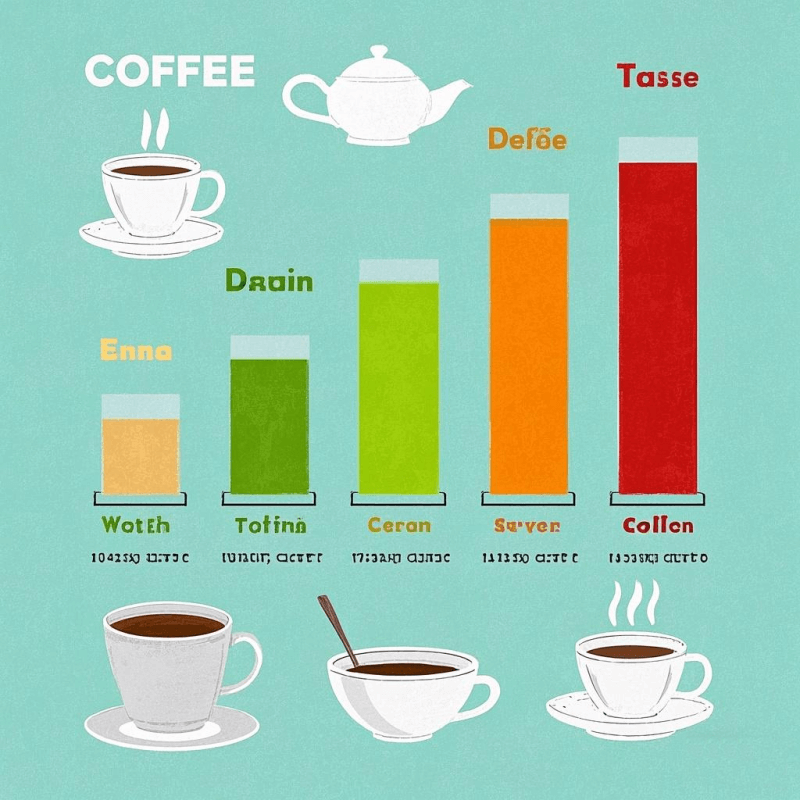
1. Introduction: Why Knowing the Amount of Caffeine in Oolong Tea Matters
In a world where energy drinks and coffee dominate the caffeinated landscape, oolong tea stands out as a sophisticated alternative—yet many overlook the amount of caffeine in oolong tea and its potential impact on health and daily routines. Whether you’re a daily sipper or new to this semi-oxidized brew, understanding how much caffeine you’re consuming is key to enjoying its benefits without side effects like restlessness or sleep disruption.
A 2024 survey by Tea Health Insights found that 78% of tea drinkers are unaware of the caffeine variability in oolong tea, highlighting the need for clarity on this topic. In this guide, we’ll decode the amount of caffeine in oolong tea, explore factors that influence it, compare it to other beverages, and discuss how to enjoy this tea mindfully for optimal health.
2. What Is Oolong Tea? A Quick Overview
The Art of Semi-Oxidation
Oolong tea is a category of tea that undergoes partial oxidation (8–85%), falling between unoxidized green tea and fully oxidized black tea. This process involves withering leaves under the sun, shaking them to bruise edges for oxidation, and stopping oxidation through pan-frying or baking. The result? A diverse range of flavors—from floral and fruity to roasted and nutty—and a caffeine content that varies widely based on processing.
Key Types of Oolong Tea
- Lightly Oxidized (10–30%):
Example: Taiwanese High Mountain Oolong, Anxi Tie Guan Yin
Profile: Fresh, floral, with lower caffeine due to shorter oxidation times.
- Heavily Oxidized (60–85%):
Example: Wuyi Da Hong Pao, Tie Luo Han
Profile: Bold, roasted, with higher caffeine from longer oxidation and roasting.
3. How Much Caffeine Is in Oolong Tea? The Numbers Breakdown
Average Caffeine Content per Cup
A standard 8-ounce (240ml) cup of oolong tea contains 30–60mg of caffeine, significantly less than coffee (95mg per cup) but slightly more than green tea (25–29mg). However, this range fluctuates based on:
- Leaf Type: Whole-leaf oolongs have more caffeine than broken leaves, as intact cells retain more compounds.
- Steeping Method: Longer steeps and higher water temperatures extract more caffeine—steeping for 5 minutes can increase content by 20% compared to 3 minutes.
- Oxidation Level: Heavily oxidized oolongs often have higher caffeine due to longer processing times that concentrate compounds.
Caffeine Content in Popular Varieties
| Oolong Type | Caffeine per 8oz Cup (mg) | Flavor Profile |
| Taiwanese Ali Shan | 35–45 | Floral, grassy, slightly sweet |
| Wuyi Rock Tea (Da Hong Pao) | 50–60 | Roasted, nutty, caramelized |
| Anxi Tie Guan Yin | 40–50 | Orchid 花香,creamy texture |
Data source: Journal of Tea Chemistry

4. Factors That Influence the Amount of Caffeine in Oolong Tea
1. Oxidation Degree
The most significant factor: lightly oxidized oolongs retain more chlorophyll and less caffeine, while heavy oxidation breaks down chlorophyll, leaving caffeine more concentrated. Think of it like wine—young white wine (light oolong) is crisper with lower alcohol, while aged red wine (heavy oolong) is bolder with higher concentration.
2. Steeping Parameters
- Water Temperature: 185°F (85°C) for light oolongs extracts 30% less caffeine than boiling water (212°F/100°C), preserving delicate flavors without over-extracting stimulants.
- Steep Time: A 2023 study in Tea Science International found that doubling steep time from 2 to 4 minutes increases caffeine extraction by 45%.
3. Leaf Quality
Premium loose-leaf oolongs have 20–30% more caffeine than teabags, as broken leaves lose compounds during processing. For balanced caffeine intake, Shop premium oolong tea with balanced caffeine that prioritizes whole-leaf integrity.
5. Caffeine in Oolong Tea vs. Other Beverages
Side-by-Side Comparison
| Beverage | Caffeine per 8oz Cup (mg) | Key Differences |
| Oolong Tea | 30–60 | Smooth caffeine release due to L-theanine |
| Green Tea | 25–29 | Lower caffeine, more catechins |
| Black Tea | 40–70 | Higher caffeine, stronger astringency |
| Coffee (brewed) | 95 | Intense caffeine spike, short duration |
| Energy Drink (8.3oz) | 70–100 | Added sugars, artificial stimulants |
The Oolong Advantage
Unlike coffee’s jittery peak, oolong tea contains L-theanine, an amino acid that promotes calm alertness. This compound binds to caffeine, creating a sustained energy lift without crashes—a unique benefit highlighted in a Healthline article on tea and cognition.
6. Caffeine’s Impact on Health: Benefits of Moderation
✅ Potential Benefits of Optimal Intake
- Cognitive Boost: 40mg of caffeine (one cup of oolong) enhances focus and memory, as shown in a 2020 study in Nutrients.
- Metabolism Support: The caffeine-L-theanine combo may boost calorie burn by 3–4% for 3 hours post-consumption.
- Heart Health: Moderate caffeine intake (≤400mg/day) is linked to a lower risk of cardiovascular diseases, according to the Mayo Clinic.
⚠️ Risks of Excessive Consumption
- Sleep Disturbance: Consuming over 200mg of caffeine after 2pm can disrupt sleep quality.
- Anxiety & Restlessness: Sensitive individuals may experience jitters with over 300mg/day.
- Digestive Issues: High caffeine can irritate the stomach lining, especially on an empty stomach.
7. Conclusion: Enjoying Oolong Tea with Caffeine Awareness
Understanding the amount of caffeine in oolong tea empowers you to tailor your consumption to your lifestyle. Whether you prefer lightly oxidized oolongs for a gentle morning lift or heavily roasted varieties for an afternoon pick-me-up, here’s how to enjoy this tea wisely:
- Control Steeping: Use lower temperatures (185°F) and shorter steeps (2–3 minutes) for less caffeine.
- Timing Matters: Avoid late-afternoon steeps if you’re sensitive to caffeine.
- Quality First: Choose whole-leaf oolongs from trusted sources—Explore the rich heritage of oolong tea in our collection to discover varieties that match your caffeine needs.
By respecting the balance of caffeine and L-theanine in oolong tea, you can enjoy its complex flavors while reaping the benefits of sustained energy and mental clarity. Cheers to mindful sipping!
Learn the amount of caffeine in oolong tea and its health effects! Discover how oxidation level, steeping methods, and more influence caffeine content. Enjoy this tea mindfully for balanced energy. 🌿
